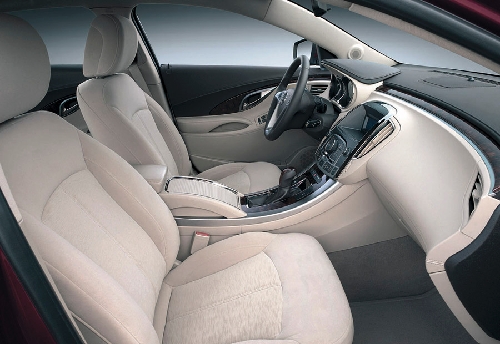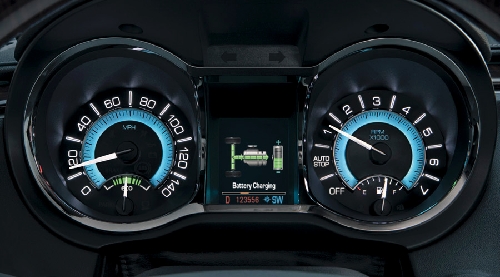Leveling playing field
Seekers of fuel-efficient mid- and full-size luxury sedans have had little choice but to shell out a hefty premium demanded by Lexus, BMW and Mercedes-Benz for a luxury gas-electric hybrid model. That's about to change later this year when General Motors' Buick division rolls out its 2012 LaCrosse equipped with the eAssist system.
As the name implies, eAssist is an electrified helper motor that doesn't independently power the car, but kicks in when the LaCrosse is accelerating or heading up hill. But that's only part of the story, so much so that GM avoids using the term "hybrid" when referencing this technology.
Without getting overly geeky, eAssist starts with a 15-horsepower liquid-cooled electric motor-generator that replaces the LaCrosse's traditional alternator. Beyond providing power enrichment for the 182-horsepower 2.4-liter four-cylinder gas engine when needed, the generator also automatically shuts it down anytime the car comes to a stop, then instantly fires the engine up again when the driver takes his or her foot off the brake. In addition, eAssist cuts off the gas engine's fuel supply whenever the LaCrosse is decelerating, while at the same time maintaining necessary power to the car's braking, steering and other electronic controls. Pretty slick stuff.
The eAssist gets its energy supply from a 115-volt lithium-ion battery that's positioned behind the rear seat. The 65-pound battery's compact size means that the LaCrosse's 60:40 split rear seat will still fold flat for additional storage as before (unlike some other hybrid models), but with only about a 15 percent reduction in trunk space.
Lithium-ion batteries tend to generate a lot of heat, as anyone who has ever operated a laptop computer on their lap can readily attest. To help cool things down, an electric fan is used that draws air from a vent located on the parcel shelf behind the rear seat. According to Buick, the fan motor will not be noisy enough to disturb any passengers.
As with most traditional hybrids, eAssist uses regenerative braking energy to electrical energy, which is fed to the battery. However unlike most traditional hybrids, the transmission consists of a modified six-speed automatic (instead of the usual continuously variable unit) that has been modified to produce quicker shifts and avoid downshifting under light acceleration (when the electric motor is usually helping out).
Complementing the powertrain alterations are the addition of aerodynamic underbody improvements, plus electronically controlled shutters behind the grille designed to prevent airflow into the engine compartment when running at highway speeds, thus also enhancing the LaCrosse's aerodynamic silhouette. And a standard "Eco" gauge also helps to inform and educate drivers as to how proficient they are at operating the LaCrosse in the most fuel-saving manner possible.
Buick promises that the driving experience with the new hardware won't differ from piloting a regular gas-engine model. But what will be different is the fuel economy rating that the LaCrosse is expected to generate: 25 mpg in the city and 37 on the highway. Those numbers represent a significant 32 percent improvement in city fuel economy and 23 percent on the highway over the 2011 LaCrosse's 19/30. That level of fuel-sipping performance is uncommon even with many compact cars. The best part about eAssist is that it will be standard on all 2012 Lacrosse and smaller Regal models with the base 2.4-liter four-cylinder powerplant. Furthermore, Buick claims the additional hardware will not result in any pricing premium. A 2011 LaCrosse without eAssist currently lists for about $27,800, including destination charges.
At that price point, Buick stands to make plenty of new friends seeking shelter from the kind of rampant fuel inflation hitting all of us in the wallet. Even better is that we don't have to downsize to get it. It also puts all automakers on notice that the days paying a hefty surcharge for hybrid-style technology are coming to an end.



















